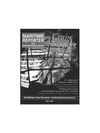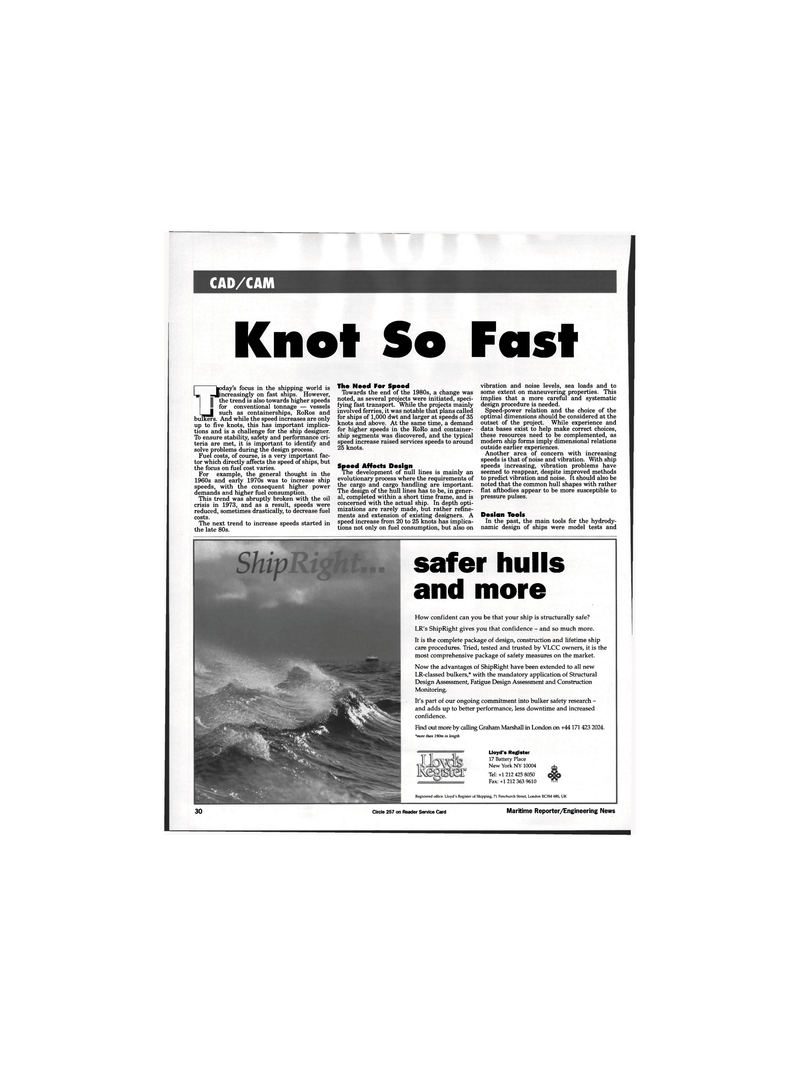
Page 28: of Maritime Reporter Magazine (July 1996)
Read this page in Pdf, Flash or Html5 edition of July 1996 Maritime Reporter Magazine
CAD/CAM
Knot So Fast
I boday's focus in the shipping world is l-a. —increasingly on fast ships. However, the trend is also towards higher speeds for conventional tonnage — vessels
L^J such as containerships, RoRos and bulkers. And while the speed increases are only up to five knots, this has important implica- tions and is a challenge for the ship designer.
To ensure stability, safety and performance cri- teria are met, it is important to identify and solve problems during the design process.
Fuel costs, of course, is a very important fac- tor which directly affects the speed of ships, but the focus on fuel cost varies.
For example, the general thought in the 1960s and early 1970s was to increase ship speeds, with the consequent higher power demands and higher fuel consumption.
This trend was abruptly broken with the oil crisis in 1973, and as a result, speeds were reduced, sometimes drastically, to decrease fuel costs.
The next trend to increase speeds started in the late 80s.
The Need For Speed
Towards the end of the 1980s, a change was noted, as several projects were initiated, speci- fying fast transport. While the projects mainly involved ferries, it was notable that plans called for ships of 1,000 dwt and larger at speeds of 35 knots and above. At the same time, a demand for higher speeds in the RoRo and container- ship segments was discovered, and the typical speed increase raised services speeds to around 25 knots.
Speed Affects Design
The development of null lines is mainly an evolutionary process where the requirements of the cargo and cargo handling are important.
The design of the hull lines has to be, in gener- al, completed within a short time frame, and is concerned with the actual ship. In depth opti- mizations are rarely made, but rather refine- ments and extension of existing designers. A speed increase from 20 to 25 knots has implica- tions not only on fuel consumption, but also on vibration and noise levels, sea loads and to some extent on maneuvering properties. This implies that a more careful and systematic design procedure is needed.
Speed-power relation and the choice of the optimal dimensions should be considered at the outset of the project. While experience and data bases exist to help make correct choices, these resources need to be complemented, as modern ship forms imply dimensional relations outside earlier experiences.
Another area of concern with increasing speeds is that of noise and vibration. With ship speeds increasing, vibration problems have seemed to reappear, despite improved methods to predict vibration and noise. It should also be noted that the common hull shapes with rather flat aftbodies appear to be more susceptible to pressure pulses.
Desian Tools
In the past, the main tools for the hydrody- namic design of ships were model tests and safer hulls and more
Find out more by calling Graham Marshall in London on +44 171 423 2024. *more than 190m in length
Lloyd's Register 17 Battery Place
New York NY 10004
Tel: +1 212 425 8050
Fax: +1 212 363 9610
Registered office: Lloyd's Register of Shipping, 71 Fenchurch Street, London EC3M 4BS, UK
How confident can you be that your ship is structurally safe?
LR's ShipRight gives you that confidence - and so much more.
It is the complete package of design, construction and lifetime ship care procedures. Tried, tested and trusted by VLCC owners, it is the most comprehensive package of safety measures on the market.
Now the advantages of ShipRight have been extended to all new
LR-classed bulkers,* with the mandatory application of Structural
Design Assessment, Fatigue Design Assessment and Construction
Monitoring.
It's part of our ongoing commitment into bulker safety research - and adds up to better performance, less downtime and increased confidence. 30 Circle 257 on Reader Service Card Maritime Reporter/Engineering News

 27
27

 29
29
